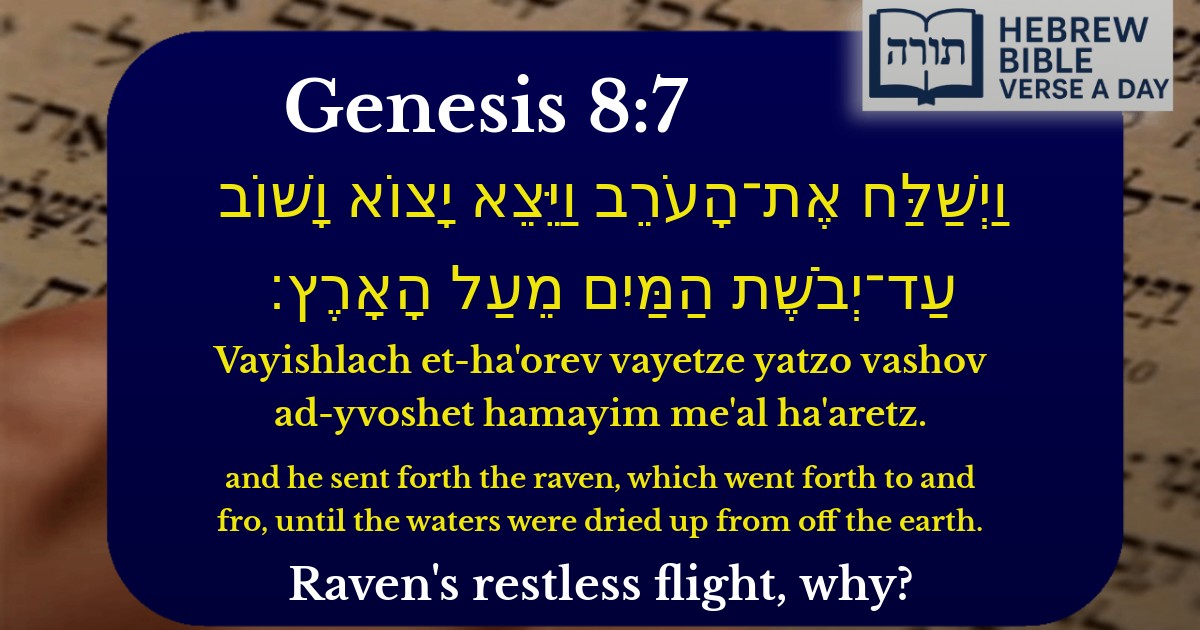Frequently Asked Questions
Q: Why did Noah send out a raven from the ark?
A: According to Rashi, Noah sent the raven to see if the floodwaters had receded enough for the land to be habitable. The raven, however, kept flying back and forth without bringing any clear information, unlike the dove that was sent later. This teaches us about the raven's nature and its different behavior compared to the dove.
Q: What does 'yatzoh vashov' (went forth to and fro) mean in this verse?
A: The phrase 'yatzoh vashov' means the raven flew back and forth without settling, as explained by Rashi. Unlike the dove, which later found a resting place, the raven continuously circled the ark, indicating that the waters had not yet fully receded and the earth was not yet dry.
Q: Why didn't the raven bring back any sign like the dove did?
A: The Midrash (Bereshit Rabbah 33:5) explains that the raven had a different purpose than the dove. The raven was sent first to test if the waters had receded, but it did not have the same instinct to return with proof. The dove, sent later, was more suited for this task, as it eventually brought back an olive leaf, showing that plant life had reappeared.
Q: What lesson can we learn from Noah sending the raven?
A: The Talmud (Sanhedrin 108b) and Midrash teach that the raven's behavior highlights the importance of patience and proper judgment. Noah had to wait and send different messengers (first the raven, then the dove) to accurately assess the situation. This teaches us that sometimes we must try different approaches to understand Hashem's will and the state of the world.
Q: How does this verse relate to the concept of trust in Hashem?
A: Rambam (Hilchot Yesodei HaTorah) teaches that Noah's actions—sending the raven and later the dove—demonstrate the balance between human effort and reliance on Hashem. Noah took practical steps to determine if it was safe to leave the ark, but he also trusted in Hashem's timing. This teaches us to act wisely while maintaining faith in divine providence.


Rashi's Explanation of the Raven's Behavior
Rashi (Bereshit 8:7) explains that the raven went "to and fro" (yatzoh vashov) because it did not fully depart from the ark. Unlike the dove, which later returned to the ark when it found no resting place, the raven flew in circles around the ark but did not venture far. Rashi suggests this behavior stemmed from the raven's suspicion that Noach favored his wife over the raven's mate (as Noach had taken pairs of all species but seven pairs of kosher animals). The raven feared Noach would let its mate perish to save his own wife, and thus hesitated to leave.
Midrashic Insights on the Raven
The Midrash (Bereshit Rabbah 33:5) elaborates on the raven's behavior, stating that it argued with Noach, questioning why it was being sent out when the earth was still covered in water. The raven accused Noach of sending it to its death, to which Noach responded with a blessing that the raven's species would survive. This Midrash highlights the raven's unique role and the Divine Providence in its survival.
Rambam's Perspective on Animal Behavior
Rambam (Moreh Nevuchim 2:48) discusses the raven's actions in the context of animal instincts. He notes that the raven's hesitation to leave the ark demonstrates the natural survival instincts embedded in all creatures by Hashem. The raven's circling behavior reflects an innate understanding of its limitations and dependence on the ark for sustenance during the flood.
Symbolism of the Raven in Jewish Thought